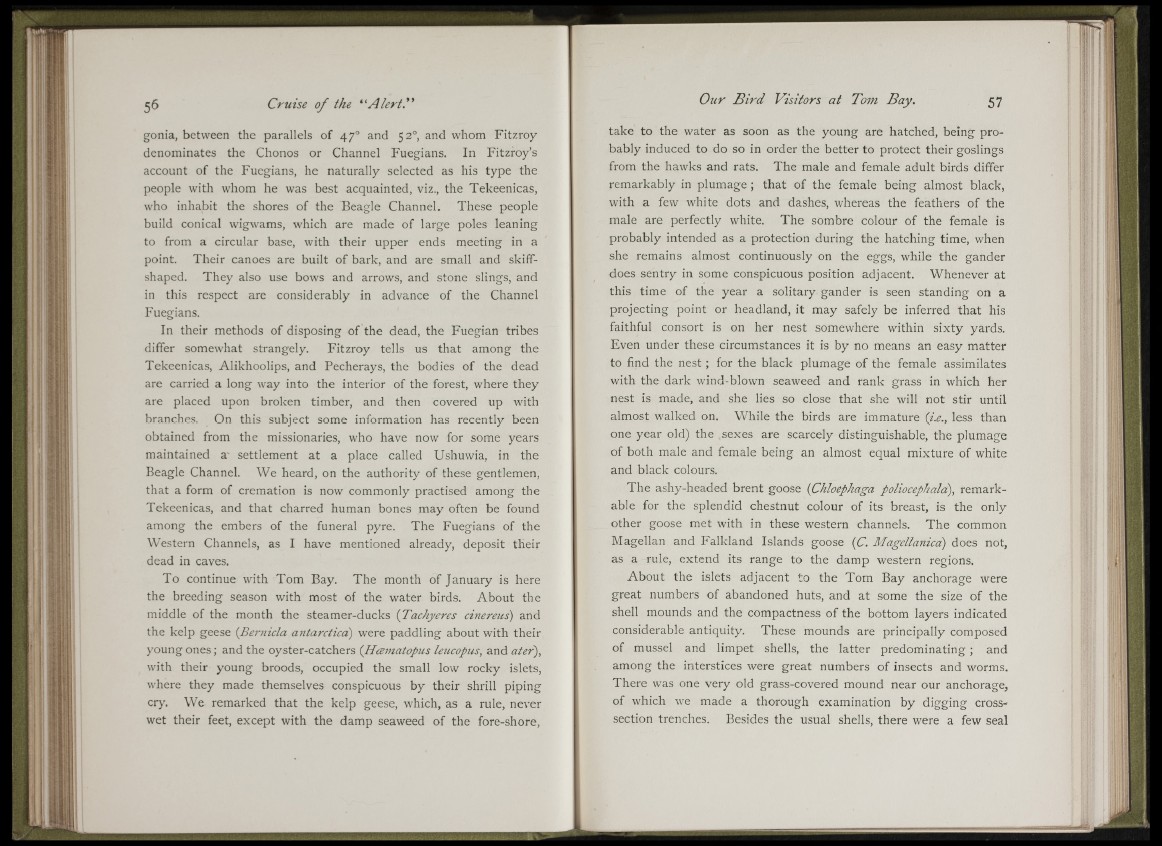
i i ;
i !
ii!
l i
j
j; i i
gonia, between the parallels of 47° and 52°, and whom Fitzroy
denominates the Chonos or Channel Fuegians. In Fitzroy’s
account of the Fuegians, he naturally selected as his type the
people with whom he was best acquainted, viz., the Tekeenicas,
who inhabit the shores of the Beagle Channel. These people
build conical wigwams, which are made of large poles leaning
to from a circular base, with their upper ends meeting in a
point. Their canoes are built of bark, and are small and skiffshaped.
They also use bows and arrows, and stone slings, and
in this respect are considerably in advance of the Channel
Fuegians.
In their methods of disposing of the dead, the Fuegian tribes
differ somewhat strangely. Fitzroy tells us that among the
Tekeenicas, Alikhoolips, and Pecherays, the bodies of the dead
are carried a long way into the interior of the forest, where they
are placed upon broken timber, and then covered up with
branches. On this subject some information has recently been
obtained from the missionaries, who have now for some years
maintained a~ settlement at a place called Ushuwia, in the
Beagle Channel. We heard, on the authority of these gentlemen,
that a form of cremation is now commonly practised among the
Tekeenicas, and that charred human bones may often be found
among the embers of the funeral pyre. The Fuegians of the
Western Channels, as I have mentioned already, deposit their
dead in caves.
To continue with Tom Bay. The month of January is here
the breeding season with most of the water birds. About the
middle of the month the steamer-ducks {Tachyeres cinereus) and
the kelp geese {Bernicla antárctico) were paddling about with their
young ones ; and the oyster-catchers {Hcematopus leucopiis, and atef),
with their young broods, occupied the small low rocky islets,
where they made themselves conspicuous by their shrill piping
cry\ We remarked that the kelp geese, which, as a rule, never
wet their feet, except with the damp seaweed of the fore-shore.
take to the water as soon as the young are hatched, being probably
induced to do so in order the better to protect their goslings
from the hawks and rats. The male and female adult birds differ
remarkably in plumage ; that of the female being almost black,
with a few white dots and dashes, whereas the feathers of the
male are perfectly white. The sombre colour of the female is
probably intended as a protection during the hatching time, when
she remains almost continuously on the eggs, while the gander
does sentry in some conspicuous position adjacent. Whenever at
this time of the year a solitary gander is seen standing on a
projecting point or headland, it may safely be inferred that his
faithful consort is on her nest somewhere within sixty yards.
Fven under these circumstances it is by no means an easy matter
to find the nest ; for the black plumage of the female assimilates
with the dark wind-blown seaweed and rank grass in which her
nest is made, and she lies so close that she will not stir until
almost walked on. While the birds are immature {i.e., less than
one year old) the sexes are scarcely distinguishable, the plumage
of both male and female being an almost equal mixture of white
and black colours.
The ashy-headed brent goose {Chloephaga poliocephald), remarkable
for the splendid chestnut colour of its breast, is the only
other goose met with in these western channels. The common
Magellan and Falkland Islands goose {C. Magellanica) does not,
as a rule, extend its range to the damp western regions.
About the islets adjacent to the Tom Bay anchorage were
great numbers of abandoned huts, and at some the size of the
shell mounds and the compactness of the bottom layers indicated
considerable antiquity. These mounds are principally composed
of mussel and limpet shells, the latter predominating ; and
among the interstices were great numbers of insects and worms.
There was one very old grass-covered mound near our anchorage,
of which we made a thorough examination by digging cross-
section trenches. Besides the usual shells, there were a few seal
Ti::::;